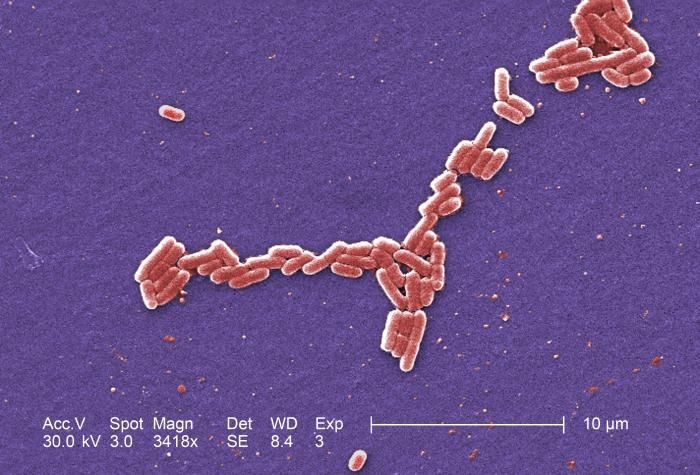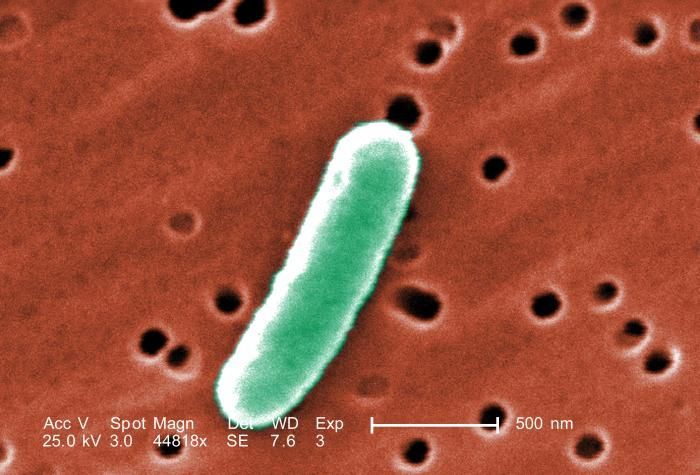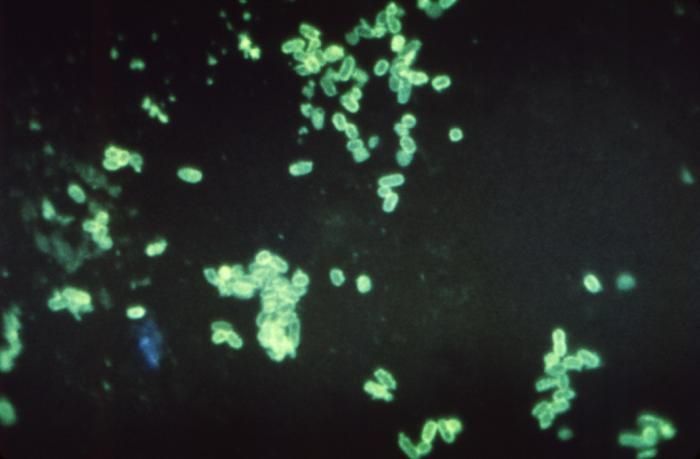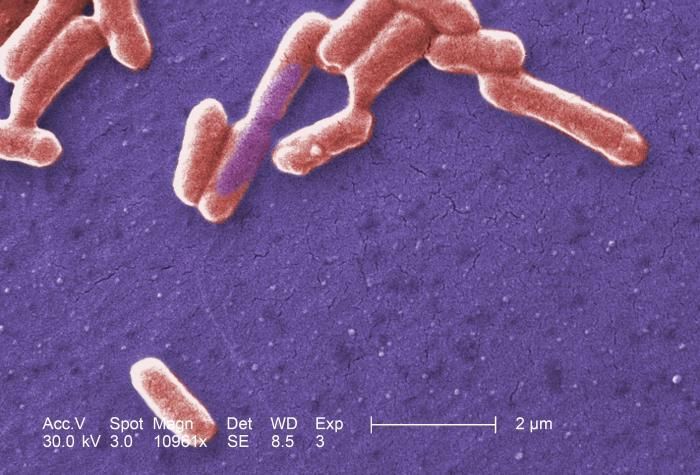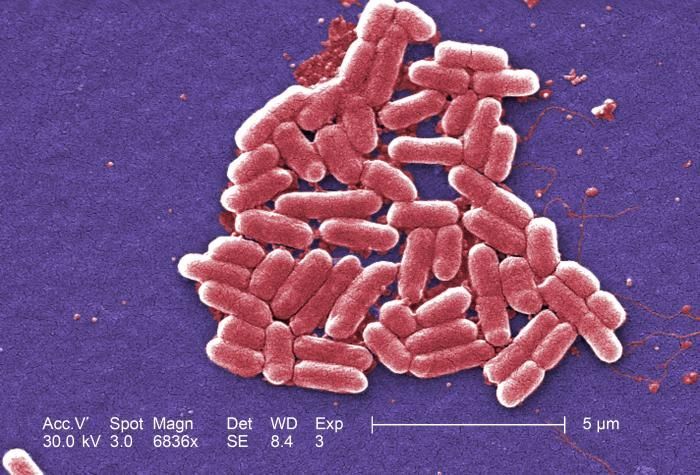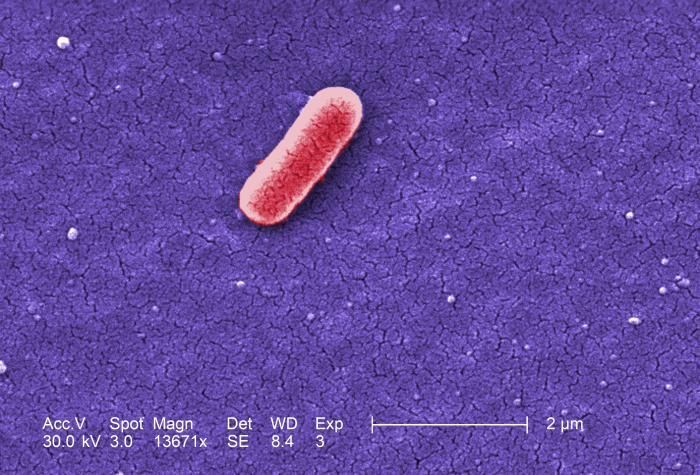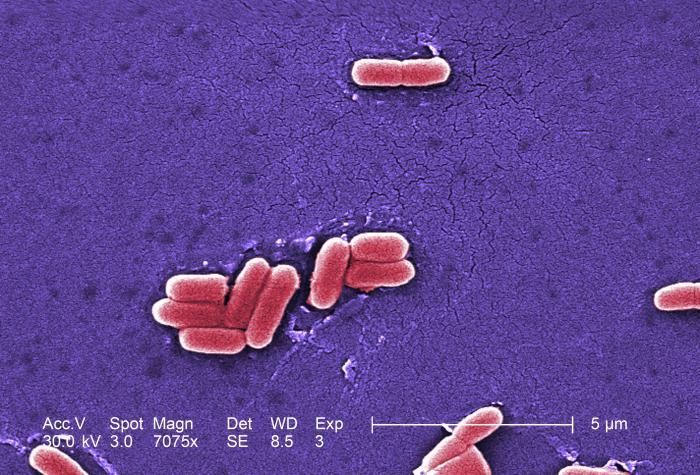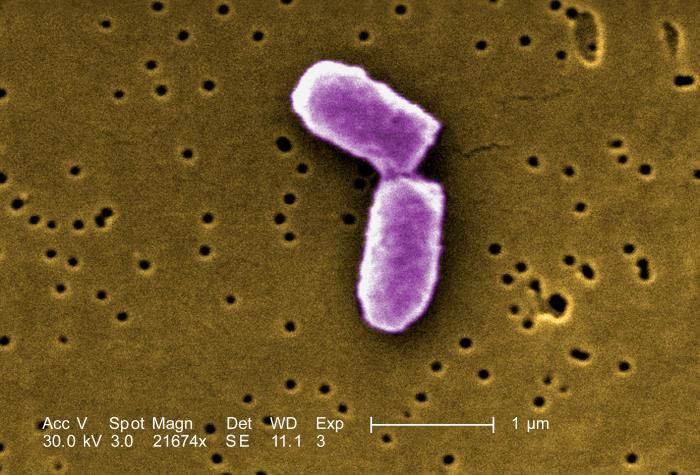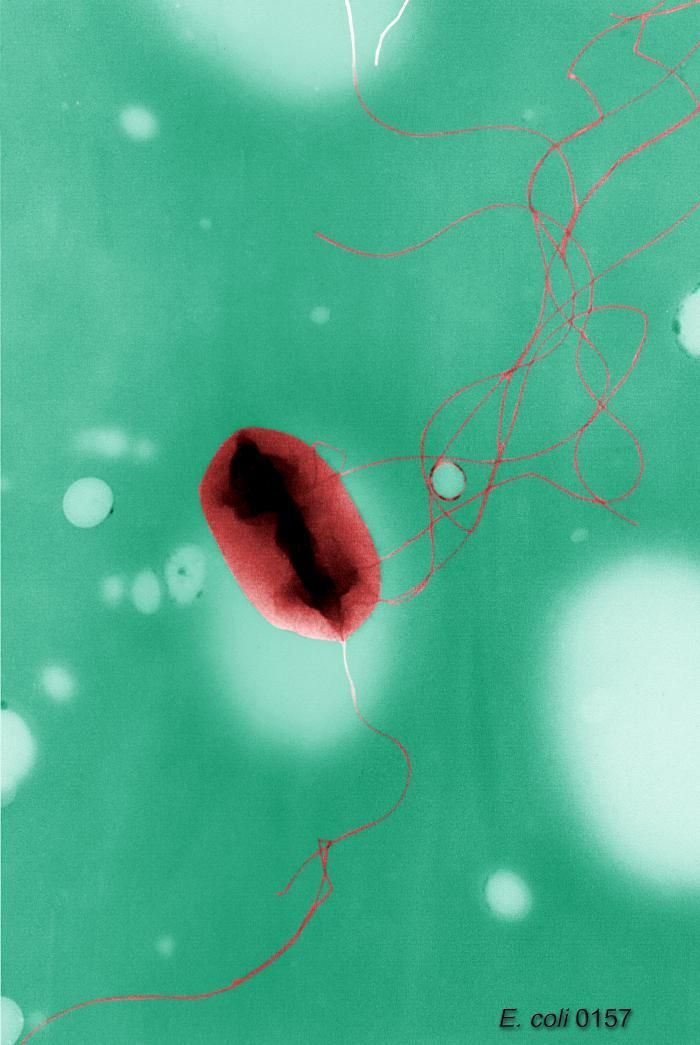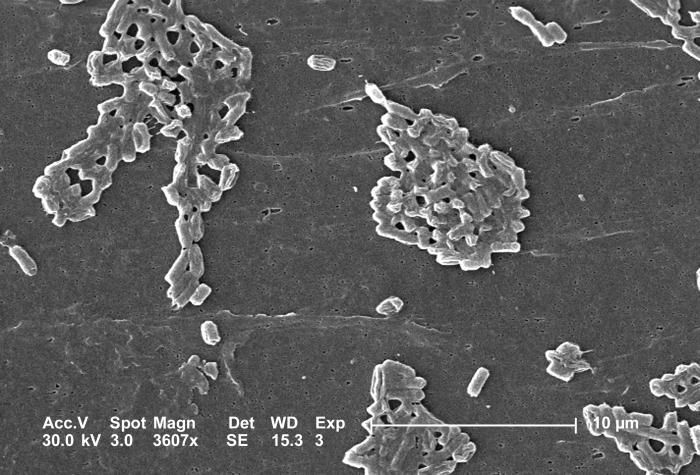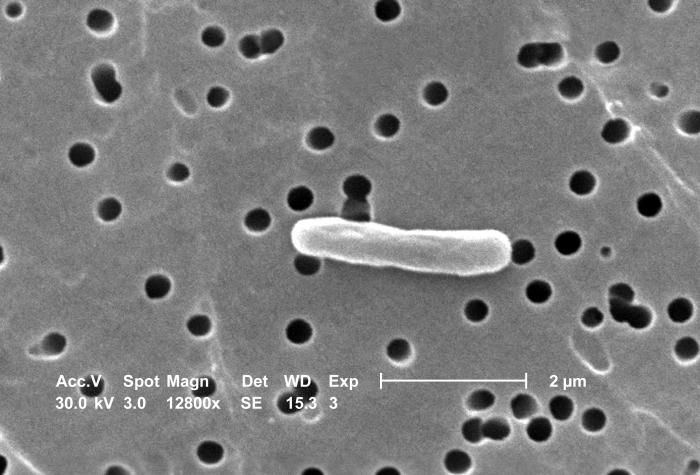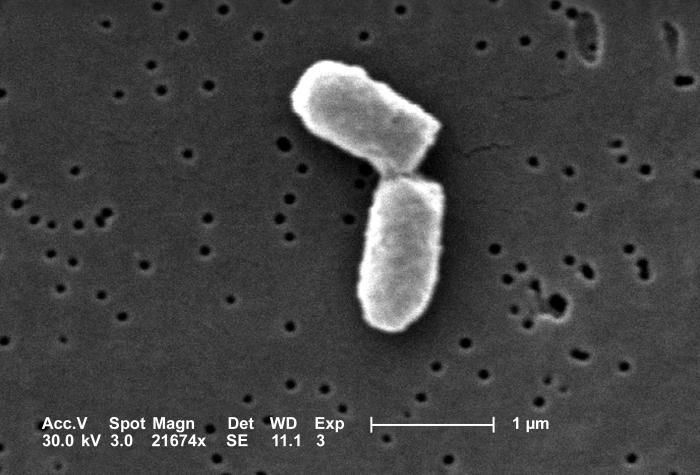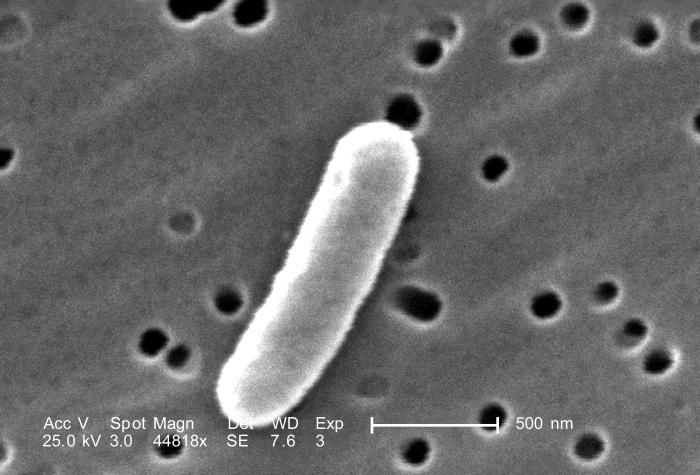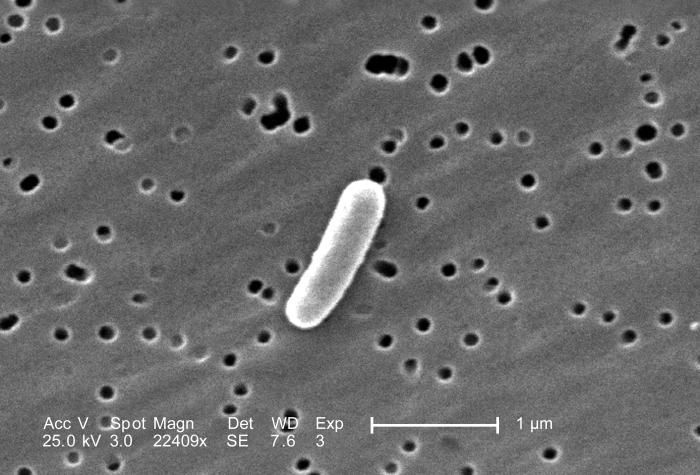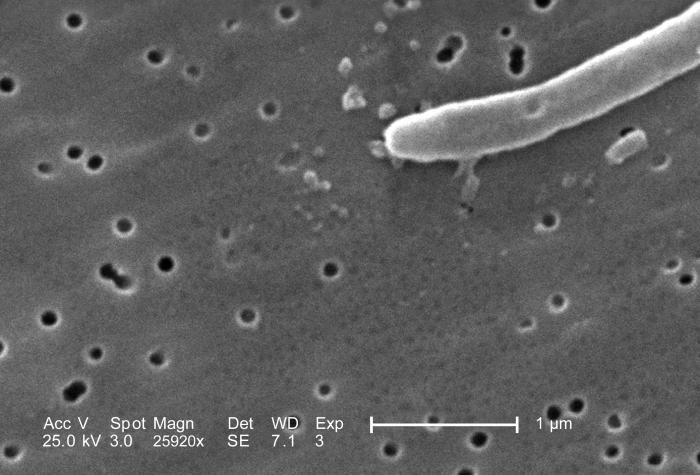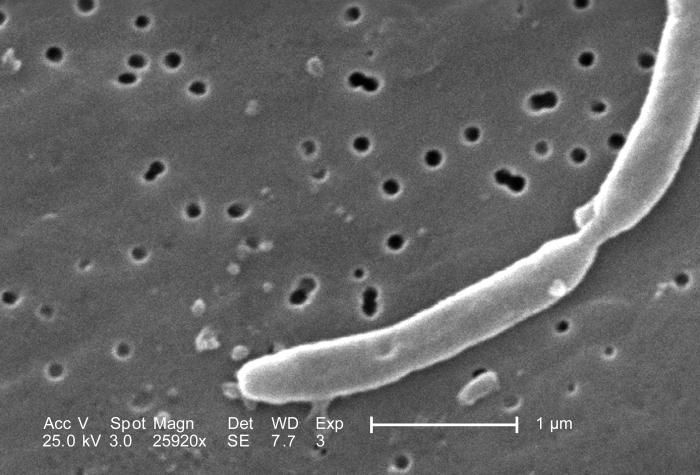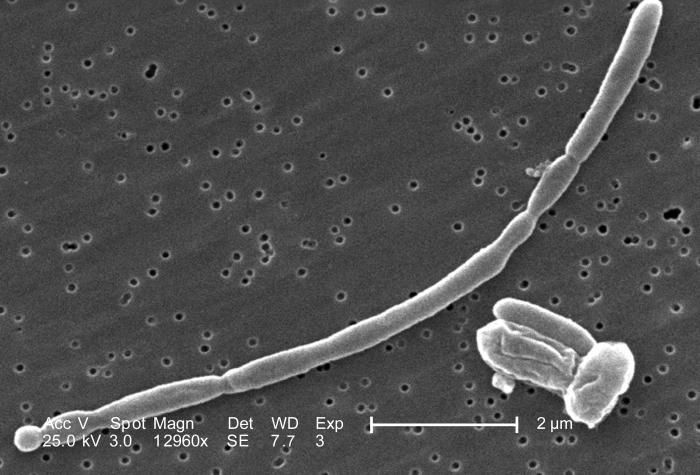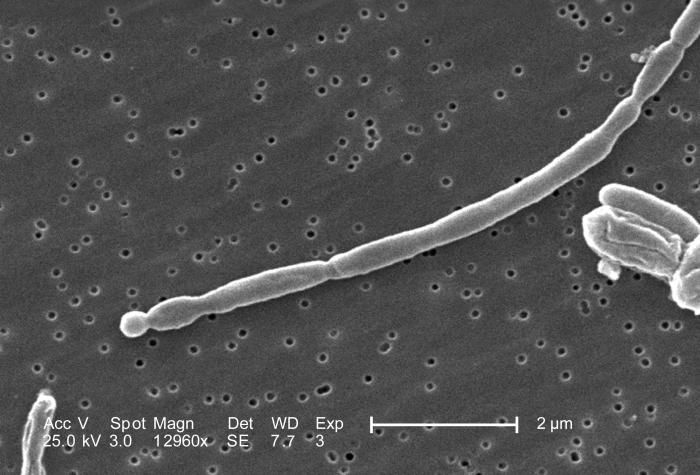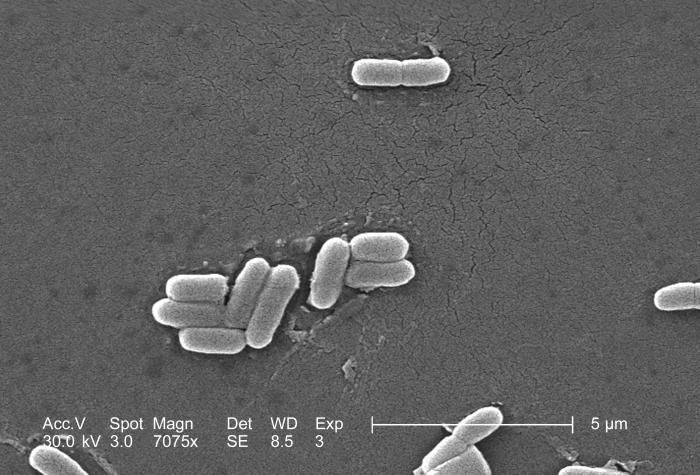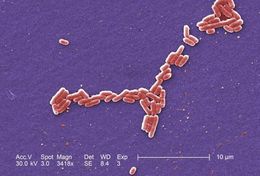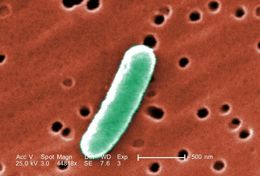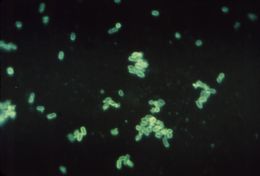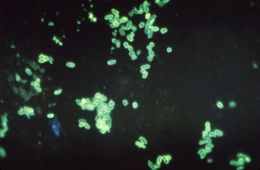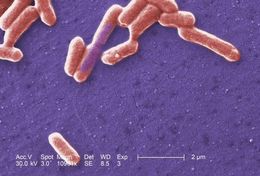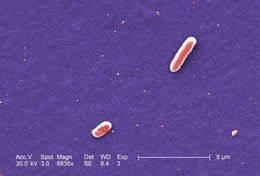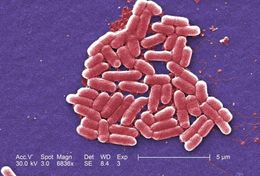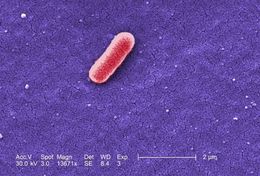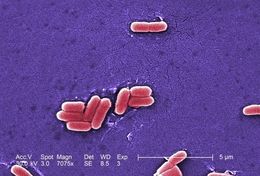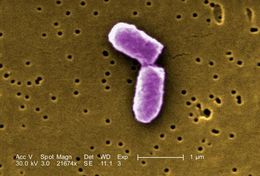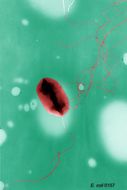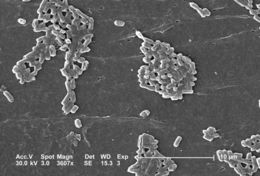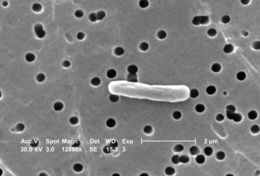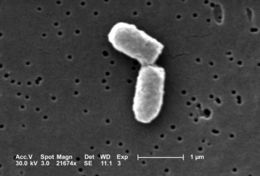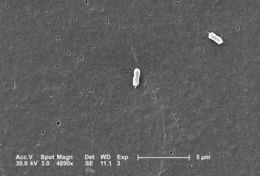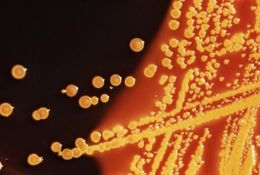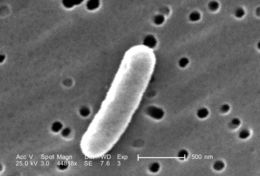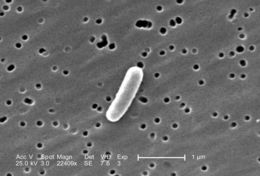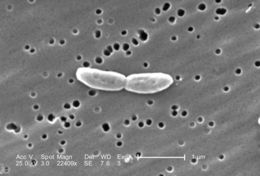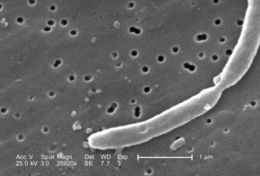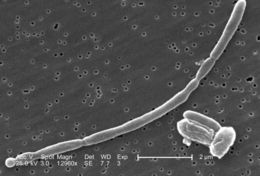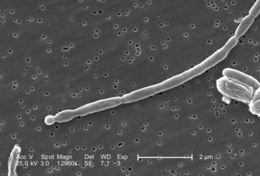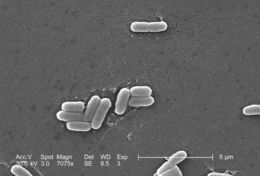-
Under a magnification of 3418x, this colorized scanning electron micrograph (SEM) depicted a number of Gram-negative Escherichia coli bacteria of the strain O157:H7. E. coli O157:H7 is one of hundreds of strains of this bacterium. Although most strains are harmless, and live in the intestines of healthy humans and animals, this strain produces a powerful toxin, which can cause severe illness.E. coli O157:H7 was first recognized as a cause of illness in 1982 during an outbreak of severe bloody diarrhea; the outbreak was traced to contaminated hamburgers. Since then, most infections have come from eating undercooked ground beef.The combination of letters and numbers in the name of the bacterium refers to the specific markers found on its surface, which distinguishes it from other types of E. coli. See PHIL 8798 for a black and white version of this image.Created: 2006
-
At an extremely high magnification of 44, 818X, twice that of PHIL 10574 and 10575, this colorized scanning electron micrograph (SEM) revealed some of the morphologic details displayed by a single Gram-negative Escherichia coli bacterium. This bacterium was a member of the strain, 0:169 H41 ETEC (Enterotoxigenic E. coli). See PHIL 10576 for a black and white version of this image.Enterotoxigenic E. coli, a common cause of bacterial diarrhea
Enterotoxigenic Escherichia coli, or ETEC, is an important cause of bacterial diarrheal illness. Infection with ETEC is the leading cause of travelers' diarrhea and a major cause of diarrheal disease in underdeveloped nations, especially among children. ETEC is transmitted by food or water contaminated with animal or human feces. Although ETEC causes a significant amount of illness worldwide, the infection will end on its own and is rarely life-threatening.Created: 2008
-
Magnified 600X, this fluorescent antibody stained photomicrograph revealed the presence of enteropathogenic Escherichia coli bacteria, which were found in a fecal smear from an infant with diarrhea. E. coli is a member of the family of bacterial organisms within the family Enteribacteriaceae, and contains the highly pathogenic strain, which has been given the label O157:H7.Created: 1960
-
Magnified 1250X, this fluorescent antibody stained photomicrograph revealed the presence of enteropathogenic Escherichia coli bacteria, which were found in a fecal smear from an infant with diarrhea. E. coli is a member of the family of bacterial organisms within the family Enteribacteriaceae, and contains the highly pathogenic strain, which has been given the label O157:H7.Created: 1960
-
Under a high magnification of 10961x, this colorized scanning electron micrograph (SEM) depicted a number of Gram-negative Escherichia coli bacteria of the strain O157:H7. E. coli O157:H7 is one of hundreds of strains of this bacterium. Although most strains are harmless, and live in the intestines of healthy humans and animals, this strain produces a powerful toxin, which can cause severe illness.E. coli O157:H7 was first recognized as a cause of illness in 1982 during an outbreak of severe bloody diarrhea; the outbreak was traced to contaminated hamburgers. Since then, most infections have come from eating undercooked ground beef.The combination of letters and numbers in the name of the bacterium refers to the specific markers found on its surface, which distinguishes it from other types of E. coli. See PHIL 8797 for a black and white version of this image.Created: 2006
-
Under a magnification of 6836x, this colorized scanning electron micrograph (SEM) depicted two Gram-negative Escherichia coli bacteria of the strain O157:H7. E. coli O157:H7 is one of hundreds of strains of this bacterium. Although most strains are harmless, and live in the intestines of healthy humans and animals, this strain produces a powerful toxin, which can cause severe illness.E. coli O157:H7 was first recognized as a cause of illness in 1982 during an outbreak of severe bloody diarrhea; the outbreak was traced to contaminated hamburgers. Since then, most infections have come from eating undercooked ground beef.The combination of letters and numbers in the name of the bacterium refers to the specific markers found on its surface, which distinguishes it from other types of E. coli. See PHIL 8799 for a black and white version of this image.Created: 2006
-
Under a magnification of 6836x, this colorized scanning electron micrograph (SEM) depicted a number of Gram-negative Escherichia coli bacteria of the strain O157:H7, which is one of hundreds of strains of this bacterium. Although most strains are harmless, and live in the intestines of healthy humans and animals, this strain produces a powerful toxin, which can cause severe illness.E. coli O157:H7 was first recognized as a cause of illness in 1982 during an outbreak of severe bloody diarrhea; the outbreak was traced to contaminated hamburgers. Since then, most infections have come from eating undercooked ground beef.The combination of letters and numbers in the name of the bacterium refers to the specific markers found on its surface, which distinguishes it from other types of E. coli. See PHIL 8800 for a black and white version of this image.Created: 2006
-
Under a high magnification of 13671x, this colorized scanning electron micrograph (SEM) depicted a single Gram-negative Escherichia coli bacterium of the strain O157:H7. E. coli O157:H7 is one of hundreds of strains of this bacterium. Although most strains are harmless, and live in the intestines of healthy humans and animals, this strain produces a powerful toxin, which can cause severe illness.E. coli O157:H7 was first recognized as a cause of illness in 1982 during an outbreak of severe bloody diarrhea; the outbreak was traced to contaminated hamburgers. Since then, most infections have come from eating undercooked ground beef.The combination of letters and numbers in the name of the bacterium refers to the specific markers found on its surface, which distinguishes it from other types of E. coli. See PHIL 8801 for a black and white version of this image.Created: 2006
-
Under a magnification of 7075x, this colorized scanning electron micrograph (SEM) depicted a number of Gram-negative Escherichia coli bacteria of the strain O157:H7. E. coli O157:H7 is one of hundreds of strains of this bacterium. Although most strains are harmless, and live in the intestines of healthy humans and animals, this strain produces a powerful toxin, which can cause severe illness.E. coli O157:H7 was first recognized as a cause of illness in 1982 during an outbreak of severe bloody diarrhea; the outbreak was traced to contaminated hamburgers. Since then, most infections have come from eating undercooked ground beef.The combination of letters and numbers in the name of the bacterium refers to the specific markers found on its surface, which distinguishes it from other types of E. coli. See PHIL 8802 for a black and white version of this image.Created: 2006
-
This colorized version of PHIL 7137 depicts a highly magnified scanning electron micrographic (SEM) view of a dividing Escherichia coli bacteria, clearly displaying the point at which the bacterias cell wall was dividing; Magnification 21674x.Created: 2005
-
Transmission electron micrograph of Escherichia coli O157:H7. See PHIL 188 for a black and white version of this image.Created: 1995
-
This scanning electron micrograph (SEM) depicts a number of rod-shaped Escherichia coli bacteria, some of which have formed colonial groupings, while others have remained isolated as single cells; Magnification 3607x.Created: 2005
-
This scanning electron micrograph (SEM) depicts a highly magnified view of a rod-shaped Escherichia coli bacterium; Magnification 12800x.Created: 2005
-
This scanning electron micrograph (SEM) depicts a highly magnified view of a dividing Escherichia coli bacteria, clearly displaying the point at which the bacterias cell wall was dividing; Magnification 21674x.Created: 2005
-
This scanning electron micrograph (SEM) depicts two Escherichia coli bacteria, clearly displaying one or more peritrichous flagella, i.e., flagella that may originate from anywhere on the bacteriums cell wall surface.; Magnification 4890x.Created: 2005
-
These are colonies of Escherichia coli bacteria grown on a Hektoen enteric (HE) agar plate medium; colonies of E. coli grown on HE agar display a raised morphology, and are yellow, to orange-yellow in coloration.Created: 1976
-
At an extremely high magnification of 44, 818X, twice that of PHIL 10574 and 10575, this scanning electron micrograph (SEM) revealed some of the morphologic details displayed by a single Gram-negative Escherichia coli bacterium. This bacterium was a member of the strain, 0:169 H41 ETEC (Enterotoxigenic E. coli). See PHIL 10577 for a colorized version of this image.Enterotoxigenic E. coli, a common cause of bacterial diarrhea
Enterotoxigenic Escherichia coli, or ETEC, is an important cause of bacterial diarrheal illness. Infection with ETEC is the leading cause of travelers' diarrhea and a major cause of diarrheal disease in underdeveloped nations, especially among children. ETEC is transmitted by food or water contaminated with animal or human feces. Although ETEC causes a significant amount of illness worldwide, the infection will end on its own and is rarely life-threatening.Created: 2008
-
At a very high magnification of 22,409X, this scanning electron micrograph (SEM) revealed some of the morphologic details displayed by a single Gram-negative Escherichia coli bacterium. This bacterium was a member of the strain, 0:169 H41 ETEC (Enterotoxigenic E. coli).Enterotoxigenic E. coli, a common cause of bacterial diarrhea
Enterotoxigenic Escherichia coli, or ETEC, is an important cause of bacterial diarrheal illness. Infection with ETEC is the leading cause of travelers' diarrhea and a major cause of diarrheal disease in underdeveloped nations, especially among children. ETEC is transmitted by food or water contaminated with animal or human feces. Although ETEC causes a significant amount of illness worldwide, the infection will end on its own and is rarely life-threatening.Created: 2008
-
At a very high magnification of 22,409X, this scanning electron micrograph (SEM) revealed some of the morphologic details displayed by two joined Gram-negative Escherichia coli bacteria. These bacteriia were members of the strain, 0:169 H41 ETEC (Enterotoxigenic E. coli).Enterotoxigenic E. coli, a common cause of bacterial diarrhea
Enterotoxigenic Escherichia coli, or ETEC, is an important cause of bacterial diarrheal illness. Infection with ETEC is the leading cause of travelers' diarrhea and a major cause of diarrheal disease in underdeveloped nations, especially among children. ETEC is transmitted by food or water contaminated with animal or human feces. Although ETEC causes a significant amount of illness worldwide, the infection will end on its own and is rarely life-threatening.Created: 2008
-
At a very high magnification of 25,920X, twice that of PHIL 10570 and 10571, this scanning electron micrograph (SEM) revealed some of the morphologic details displayed a single Gram-negative Escherichia coli bacterium. This bacterium was a member of the strain, 0:169 H41 ETEC (Enterotoxigenic E. coli).What is ETEC?ETEC was first recognized as a cause of human diarrheal illness in the 1960s. It have since emerged as a major bacterial cause of diarrhea among travelers and children in the developing world. ETEC is increasingly recognized as an important cause of foodborne illness in developed nations, such as the United States.ETEC produces two toxins, a heat-stable toxin (known as ST) and a heat-labile toxin (LT). Although different strains of ETEC can secrete either one or both of these toxins, the illness caused by each toxin is similar.Created: 2008
-
At a very high magnification of 25,920X, twice that of PHIL 10570 and 10571, this scanning electron micrograph (SEM) revealed some of the morphologic details displayed by a two joined Gram-negative Escherichia coli bacteria. These bacteria were members of the strain, 0:169 H41 ETEC (Enterotoxigenic E. coli).Enterotoxigenic E. coli, a common cause of bacterial diarrhea
Enterotoxigenic Escherichia coli, or ETEC, is an important cause of bacterial diarrheal illness. Infection with ETEC is the leading cause of travelers' diarrhea and a major cause of diarrheal disease in underdeveloped nations, especially among children. ETEC is transmitted by food or water contaminated with animal or human feces. Although ETEC causes a significant amount of illness worldwide, the infection will end on its own and is rarely life-threatening.Created: 2008
-
At a high magnification of 12,960X, this scanning electron micrograph (SEM) revealed some of the morphologic details displayed by a number of joined Gram-negative Escherichia coli bacteria. These bacteria were members of the strain, 0:169 H41 ETEC (Enterotoxigenic E. coli).Enterotoxigenic E. coli, a common cause of bacterial diarrhea
Enterotoxigenic Escherichia coli, or ETEC, is an important cause of bacterial diarrheal illness. Infection with ETEC is the leading cause of travelers' diarrhea and a major cause of diarrheal disease in underdeveloped nations, especially among children. ETEC is transmitted by food or water contaminated with animal or human feces. Although ETEC causes a significant amount of illness worldwide, the infection will end on its own and is rarely life-threatening.Created: 2008
-
At a high magnification of 12,960X, this scanning electron micrograph (SEM) revealed some of the morphologic details displayed by a number of joined Gram-negative Escherichia coli bacteria. These bacteria were members of the strain, 0:169 H41 ETEC (Enterotoxigenic E. coli). See PHIL 11379 for a colorized version of this image.What is ETEC?Escherichia colii is a bacterium that normally lives in the intestines of humans and other animals. Most types of E. coli are harmless, but some can cause disease. Disease-causing E. coli are grouped according to the different ways by which they cause illness. Enterotoxigenic Escherichia coli, or ETEC, is the name given to a group of E. coli that produce special toxins which stimulate the lining of the intestines causing them to secrete excessive fluid, thus producing diarrhea. The toxins and the diseases that ETEC causes are not related to E. coli O157:H7.Created: 2008
-
Under a magnification of 7075x, this scanning electron micrograph (SEM) depicted a number of Gram-negative Escherichia coli bacteria of the strain O157:H7, which is one of hundreds of strains of this bacterium. Although most strains are harmless, and live in the intestines of healthy humans and animals, this strain produces a powerful toxin, which can cause severe illness.E. coli O157:H7 was first recognized as a cause of illness in 1982 during an outbreak of severe bloody diarrhea; the outbreak was traced to contaminated hamburgers. Since then, most infections have come from eating undercooked ground beef.The combination of letters and numbers in the name of the bacterium refers to the specific markers found on its surface, which distinguishes it from other types of E. coli. See PHIL 10066 for a colorized version of this image.Created: 2006


